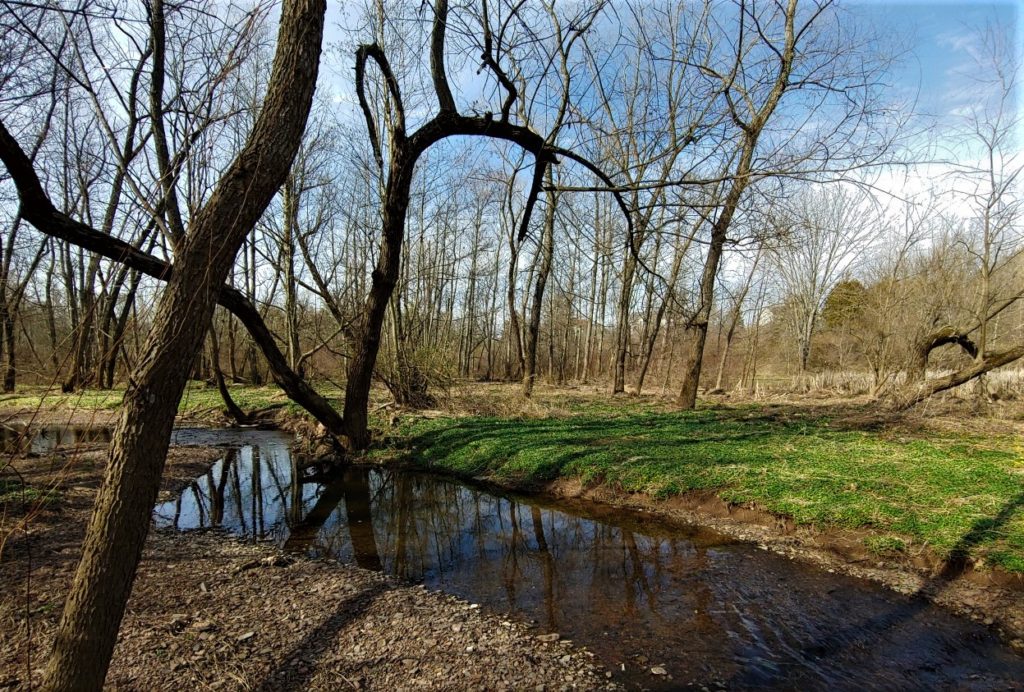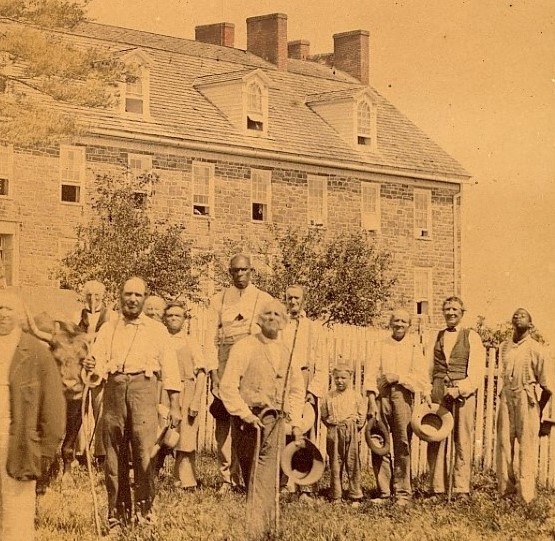A creek near Wycombe is a reminder of the heroism of local folks to rescue a beloved man from slavery.
Wycombe is a postcard of 19th Century Americana with its Victorian-era rail depot and tidy two-story homes lining the main drag. Just below the village is Robin Run, a two-mile-long tributary to Neshaminy Creek. It is there in 1844 that a bloody fight for freedom by a fugitive slave occurred and galvanized local citizens to save him.
I recently visited the stream to better envision history, following Dark Hollow Road to where it ends in a cul-de-sac between a farm field and expensive tract homes. Parking the car, I worked my way through thorny vines along Robin Run until my path intersected a muddy trail tossed up by horse hooves. Dodging my way, I followed it to an open view of Robin Run Reservoir built in the 1970s to hold back flood waters on Neshaminy Creek. Climbing onto the lake’s earthen dam, I imagined the distant past.

The year was 1822. Slavery had been outlawed in Pennsylvania for 42 years. Yet much of the U.S. still allowed it. Federal law required fugitive slaves to be returned to owners. Slave masters and bounty hunters roamed Pennsylvania to capture them.
Here in Bucks, a group of free slaves and runaways sheltered on Buckingham Mountain 2 miles north of Wycombe. They were protected by Quakers who also offered employment at local rock quarries and farms. The mountain was a prefect refuge. It was heavily wooded and roughed up by limestone boulders with caves in which to hide. Through the early 1800s, the mountain community built log and stone cabins plus a log chapel they named Mount Gilead visited by roving African Methodist Episcopal ministers. The mountain served as a staging area for runaway slaves directed north to ultimate freedom in Canada on a secretive network of abolitionist safe places called “the Underground Railroad”.
In 1833, a 33-year-old runaway slave with a gentle disposition arrived after escaping slave master William Anderson in York, Md. Benjamin Jones melded well with the mountain folk and area Quakers. He decided to stay. He was remarkable for his size, nearly 7 feet tall and muscular. Some called him “Little Ben” to get a chuckle. Big Ben, as he later came to be known, earned a living helping them.
In the spring of 1844, an attorney tipped off Anderson to Jones’ location. The slaver and four bounty hunters found him chopping wood along Robin Run. With Anderson waiting in a carriage out of sight, three others approached Jones with clubs and ordered his surrender. He refused. Wielding their weapons, they swarmed him. Jones stood his ground, swinging his axe wildly. Badly injured, he gave up. Bound and chained, he was hauled away.
As news spread, Buckingham Quakers were furious. One resident in a letter to Jacob Byrnes in Wilmington, Dela. described what happened. “The neighborhood talk for a few days past has been concerning the capture of that giant of a runaway slave known as the Congo man Little Ben. He was chopping in the woods when he was accosted by three strangers. The strangers told him he must go with them. He refused and they fell on him. Ben fought like a hero, came near cutting one fellow’s head off with his axe but was at last so disabled by their clubs that he had to give up. That notorious character Squire Bailey is generally suspected of having given information of Ben. If guilty, he ought certainly to feel the Negro’s vengeance.”
Anderson transported Jones to Philadelphia where he was placed on a ship to Baltimore and a prison operated by infamous slave trader Hope Slatter. She set a sale price of $700 (about $19,000 today) with intention to transfer him to New Orleans if no sale could be consummated.
Back in Bucks, local Quakers aided by others in Philadelphia raised the $700 and rode to Baltimore to retrieve Big Ben. The sale effectively made him a legally free man for the first time in his life. He returned to Buckingham Mountain, married Sarah Johnson and lived in peace though continuing to suffer from injuries on Robin Run. At age 65, he moved into the Bucks County Almshouse in Doylestown Township where he died in 1875.
Mount Gilead Church has survived to the present day. Rebuilt as a stone, one-room church in 1852, it was a lantern in the storm for runaway slaves before the Civil War. On the crest of the mountain off steep Holicong Road, the building remains an historic treasure looking much like it did when built. Every year, descendants of slaves and others reopen it for worship on Easter sunrise, Memorial Day and other special occasions to recall the bitter though valiant past. It’s then the inspirational story of Big Ben and his rescue is retold to new generations.
Sources include the Mount Gilead website at www.mountgilead.org/the-history-of-mount-gilead ; “The History of Bucks County Pennsylvania” in the chapter “Negro Slavery in Bucks County” by W.W.H. Davis published in 1905; “The North Star”, an independent film loosely based on Big Ben’s life distributed in 2015, and a letter from “Richard” of Buckingham Township to Jacob F. Byrnes of Wilmington, DE archived at the Bucks County Historical Society in Doylestown.

